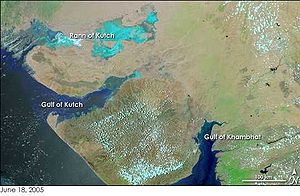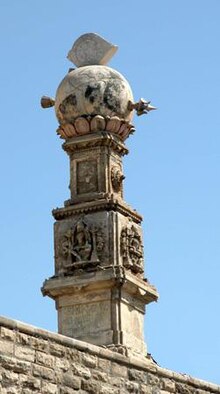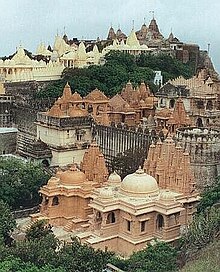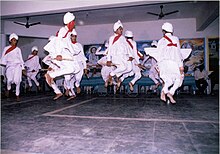Kathiawar: Difference between revisions
| Line 75: | Line 75: | ||
* Narayan Swami - Devoted Bhajanik - Singer, a divine soul |
* Narayan Swami - Devoted Bhajanik - Singer, a divine soul |
||
* [[Morari Bapu]] - Saint, preacher, Teacher, Thinker |
* [[Morari Bapu]] - Saint, preacher, Teacher, Thinker |
||
* [[Ramesh Bhai Ojha]] (Hindi: रमेश भाई ओझा) is a Hindu spiritual leader. He is a preacher of Vedanta Philosophy. |
|||
=== Society, Ideology, Politics, Leadership === |
=== Society, Ideology, Politics, Leadership === |
||
Revision as of 22:31, 8 July 2013

- This is about the peninsula. See also Kathiawar Agency, Kathiawar cricket team.
Kathiawar or Kathiawad (Gujarati: કાઠીયાવાડ [kaʈʰijaʋaɽ]) is a peninsula in western India, which is part of the Saurashtra region on the Arabian Sea coast of Gujarat state. It is bounded on the north by the great wetland of the Rann of Kutch, on the northwest by the Gulf of Kutch, on the west and south by the Arabian Sea, and on the southeast and east by the Gulf of Khambhat. Jigat Point is located at its western and Diu Head at its southern apex.
Etymology and history


Kathiawar, also (Kattywar), the peninsula gets its name from the prominence of the Kathi and Ahir community which was widespread in the region and dominated central Saurashtra in particular for some centuries. And this is how it influenced the Saurashtra as Kathiawar, whereas history of Saurashtra together is pretty old. Although the Kathis are supposed to have migrated to the area in the 16th century, they have played an important part in the documented history of the region. During the reign of Gurjar Pratihar ruler Mihir Bhoj, the Gurjar empire had its one extremity as Kathiawar, other being Bay of Bengal.[1] Haddola inscription confirms that Gurjar Pratihars continued to rule in this region during reign of Mahipala I too.[2] The peninsula of Saurashtra dotted by antiquity and consistent historical turnover since prehistoric times to early periods of Mahabharata through Indus civilization, remained influenced by Kathi people particularly between 16th century AD to very much till mid 20th century and therefore the emergent name of Kathiawar became a favorite alternative to the region of Saurashtra.
In geopolitical context, the area of Kathiawar is core or central Saurashtra. In feudal times, there were certain principle divisions of Saurashtra falling under princely states, namely Kathiawad, Sorath, Gohilwad, Halar, Panchal & Zalawad, Nagher, Okha Mandal, etc. But the principle Kathiawar covered parts of mainly Rajkot district, Gohilwad (Bhavnagar), Sorath (Junagadh, Amreli) and Panchal (particularly the delta of now Bhavnagar-Surendranagar-Ahmedabad districts and its interiors) making the Kathiawad shaped almost as an oval occupying the central Saurashtra. Some historians suggest and are of opinion for Kathi people are basically Scythians who migrated to Surashtra (referred to as Saraostus as well, by Greeks) around second century B.C.For a long span of time, the name Sorath remained limited to the region when Chudasama Rajput (Raa' dynasty) ruled from 9th centuary up to 15th century from 875 upto 1473.
Concurrently, major Rajput clans that held a sway over this region include the Walas ( Kathis ), Jethwas, Raijadas, Chudasamas, Gohils, Parmars, Jhalas, Jadejas, Chavdas, Solankis, Patgirs or Pargirs, and Sarvaiyas, Savjis. Most of the princely states of Kathiawar were brought under the British protectorate by 1820, but from Kathiawad first treaty with the British was made by Vira Wala of Jetpur with Col.Walker at Baroda on 26 October 1803.
Political history
Before Indian independence in 1947, most of Kathiawar was divided into numerous princely states, ruled by local potentates who acknowledged British suzerainty in return for local sovereignty. These states comprised the Kathiawar Agency. The rest of the peninsula, chiefly in the east along the Gulf of Cambay, were districts ruled directly by the British as part of British India's Bombay Presidency, which included part of the peninsula.
After Indian independence, the states of Kathiawar acceded to India. In 1947, Junagadh's Muslim ruler desired to accede his territory to Pakistan, but the predominantly Hindu population rebelled, and while the prince fled to Pakistan, a plebiscite was conducted, as a result of which the kingdom was merged into the Indian Union. Pakistan still retains a claim to it. The former princely states of Kathiawar were grouped into the new province of Saurashtra, which became a state in 1950. In 1956, Saurashtra was merged into Bombay State, and in 1960, Bombay state was divided along linguistic lines into the new states of Gujarat and Maharashtra. Diu remained in Portuguese hands until 1961, when it was occupied by Indian troops, then became integrated into India as part of the union territory of Goa, Daman and Diu in 1962.
Major cities



The major cities of Kathiawar are Rajkot in the center of the peninsula, Jamnagar on the Gulf of Kutch, Bhavnagar on the Gulf of Khambhat, Surendranagar and the historic city Wadhwan in the central portion of Gujarat, Porbandar on the west coast, historic city of Junagadh on the South. Diu, an island town formerly part of Portuguese India and now part of the Indian union territory of Daman and Diu, lies off the south coast of Kathiawar. The city of Somnath and its famous temple are also located on the south coast. Reliance Industries Limited founded by Dhirubhai Ambani, operates the oil refinery at Jamnagar, which is the world's largest grass-roots refineries. The world's largest shipbreaking yard is in Gujarat near Bhavnagar at Alang. Somnath is one of the 12 Jyotirlings in India. The other equally famous & important town to Hindus is Dwarka, where Lord Krishna is worshipped. Palitana is sacred to the Jains & is one of a kind in India, with hundreds of temples atop a hill. Sasan Gir located in the Gir Forest is a staging post for Lion Safaris, being the only habitat of the Asiatic Lion in Asia.
On the national highway 8B, it has smaller cities like Gondal, Jetpur, Dhoraji and Upleta. Gondal was a princely state which ranked education very high for society while Dhoraji was its part. Dhoraji, Upleta, and Gondal were also part of the erstwhile oil mill cartel, which once called the shots in the political corridors of Gujarat state. Also Dhoraji is ranked one of a leading education centre that attracts several students from different parts of the State to come and especially pursue their Board exams for Standard 10 & 12. Jetpur, a city on the banks of Bhadar River, still remains one of major hub for dyeing industry, which colours traditional Indian women wear called—Sari. This region had also important plastic factories which over a period of time had lost its luster. The town of Amarvalli (Amreli) is famous for its many Hindu monks.
Geography and ecosystem
The natural vegetation on most of the peninsula is xeric scrub, part of the Northwestern thorn scrub forests ecoregion. A range of low hills, known as the Gir Hills, occupies the south-central portion of the peninsula. The highest of these is Girnar. The hills are home to an enclave of tropical dry broadleaf forest, part of the Kathiawar-Gir dry deciduous forests ecoregion. Gir National Park, which includes the forested hills around Girnar, is home to the last remaining Asiatic lions left in the wild. Other national parks on Kathiawar are Blackbuck National Park (Velavadar) on the Gulf of Cambay and Marine National Park, on the Gulf of Kutch near Jamnagar.
Antiquity (Places: History, Archaeology, Nature, Religion)
- Dwarika
- Somnath
- Sasan Gir and interiors / Kathi territories in Amreli-Bhavnagar districts
- Vallabhi
- Porbandar
- Junagadh
- Shatrunjay Hills, Palitana
- Sihor
- Virpur and Gondal
- Jamnagar & Marine National Park
- Velavadar
- Old cities of Wadhvan, Morbi, Wankaner
- Diu, India
People (Kathis)

Kathiawar or Saurashtra hosts a large number of communities, castes and settlements in the region, though the Kathis after who the name of Kathiawar became popular is a distinguished group. In a normal practice today, a person from Kathiawar is called a "Kathiawadi". For more information on the Kathis (Rajputs of Gujarat), read Colonel James Tod's Annals and Antiquities of Rajasthan,[3] especially the chapter on the 36 Royal Races of India. Kathis migrated from the Punjab to Kutchh and then to Saurashtra and made treaty with the Wala rajputs of Saurashtra and started matrimonial relations with the local Rajputs, most probably Walas, thus the Kathi community of today is a mix of Kathis from the Punjab and the local ancient Rajputs of Saurashtra. Savji community is also one of Kathi identities in Maharashtra and Gujarat. Presently the people/community known as Katwa or Katwe in Maharashtra(in India) & Kathia and Kathio in Punjab and Sindh (in Pakistan) are also of Kathiawar origin.
Notable characters and figures
The list of some divine, notable figures, characters and events related to Kathiawar-Saurashtra can be very exhaustive. Covering different sections, fields and class of society, a few of them are as following:
Religion, Pre-history, Spirituality
- Sudama - Krishna's friend and a character from Mahabharata
- Baba Balak Nath - One of the legendary Naths and Chaurasi Siddhas
- Neminath - One of the Siddhas and 22nd Jain Tirthankar
- Gebinath - One of the Naths and a great yogi
- Narsinh Mehta - Poet and Saint
- Dayanand Saraswati - Hindu religious scholar, reformer, and founder of the Arya Samaj
- Jalaram Bapa - A mystic and Saint
- Sant Devidas - A mystic and saint
- Jesal Pir – Mystics ‘Jesal Toral’
- Sati Toral – Mystics ‘Jesal Toral’
- Aapa Jadra - A mystic and saint, Gebinath Sect
- Dan Maharaj - A mystic and saint, Gebinath Sect
- Visaman Bhagat - A mystic and saint at Paliyad
- Ganga Sati - A mystic and saint
- Aapa Giga - A mystic and saint, Gebinath Sect
- Shrimad Rajchandra - A prominent Jain philosopher
- Bajrang Das Bapa – A mystic and saint
- Narayan Swami - Devoted Bhajanik - Singer, a divine soul
- Morari Bapu - Saint, preacher, Teacher, Thinker
- Ramesh Bhai Ojha (Hindi: रमेश भाई ओझा) is a Hindu spiritual leader. He is a preacher of Vedanta Philosophy.
Society, Ideology, Politics, Leadership
- Mohandas Karamchand Gandhi - pre-eminent political and ideological leader of India, and Father of Nation
- Muhammad Ali Jinnah - Lawyer, politician, statesman and the founder of Pakistan
- U. N. Dhebar – Freedom Fighter (Indian independence), and President of the Indian National Congress
- Virchand Gandhi - First Gujarati Patriot from Mahuva to visit USA officially and Participate in First World Religion Parliament, 1893, who was contemporary to Mohandas Karamchand Gandhi, Swami Vivekananda, Lokmanya Tilak, Justice Govind Ranade. (key Member of Indian National Congress)
Governance, Nobility, Reforms, Politics
- Maharaja Sir Takhtsinhji Gohil of Bhavnagar – Reformist and progressive ruler, also constructed Bhavnagar State Railway covering Saurashtra
- Maharaja Bhagvatsinhji of Gondal - A progressive and enlightened ruler, wrote classical and rare ‘Bhagavadgomandal’, dictionary cum encyclopedia of Saurashtra - Gujarat and Gujarati language
- Maharaja Krishnakumar Sinjhji Gohil - Reformist, progressive and noble Maharaja of Bhavnagar
- Balwantrai Mehta - Freedom fighter, social worker and pioneer of concept of Panchayati Raj
- Jivraj Mehta - Politician, first Chief Minister of Gujarat
- Vadilal Chitrabhuj Gandhi - Early Top Congress politician and Industrialist from bhavnagar to Mumbai.
Education, Creativity, Reforms, Society
- Sir Prabhashankar Pattani – Visionary and Reformist, Diwan of Bhavnagar State, Leading role for Saurashtra
- Nanabhai Bhatt (Lokbharti) - Founder of Lokbharti and Dakshinamurti, Educationist, Creative Writer, Thinker, Rural Welfare & Education
- Gijubhai Badheka - Educationist and reformer, Montessori Education, Spiritual-intellectual builder of Dakshinamurti
- Harbhai Trivedi - Educationist, Thinker
- Jugatram Dave - Social Worker, Educationist
Art, Literature, Poetry, Journalism, Socialism
- Jhaverchand Meghani - Litterateur, social reformer and freedom fighter
- Kalaguru Ravishankar Raval- a painter, art teacher, art critic, journalist and essayist
- Dalpatram - Eminent poet of Gujarati literature
- Nanalal Dalpatram Kavi - Noted author and poet
- Sursinhji Takthasinhji Gohil - Known as Kalapi - Poet, Gujarati literature - Royal family
- Dula Bhaya Kag - Renowned poet, social reformer and freedom fighter
- Amrut Ghayal - Eminent poet and Shayar of Gujarati Ghazal
- Kavi Kant – Poet
- Harilal Upadhyay[4] - One of the all-time great authors in the Gujarati language
- Gunvantray Acharya - Essayist, Journalist, Novelist, Playwright
- Chunilal Madia - Author, Playwright, Poet, Journalist, Editor
- Manubhai Pancholi - 'Darshak', Author, Educationist, Thinker
- Ghulam Mohammed Sheikh - Internationally renowned painter, writer, art critic
- Harkishan Mehta - Author, Thinker, Novelist, Journalist, Editor
- Rajendra Shukla - Eminent Poet
- Kanti Bhatt - Author, Journalist, Thinker
Sports, Adventure
- K. S. Ranjitsinhji - Maharaja of Nawanagar, cricketer
- Kumar Shri Duleepsinhji - Indian Crickter, Princely States
- Vinoo Mankad – AKA Vinu Mankad, Indian Cricketer
- Ashok Mankad - Indian Cricketer
- Dilip Doshi - Indian Cricketer
- Karsan Ghavri - Indian Cricketer
- Ashok Patel – Indian Cricketer
- Dhiraj Parsana - Indian Cricketer
- Niranjan Shah - Indian Cricketer, BCCI Committee
- Ajay Jadeja - Indian Cricketer
- Kirit Oza - Basket Ball Player, Coach
- Divya Gohil - Ranked Table Tennis Player
- Ravindra Jadeja - Indian Cricketer
- Siddharth Trivedi - Indian Cricketer
- Cheteshwar Pujara - Indian Cricketer
Cinema, Entertainment, Music, Folklore
- Ajit Sheth - Singer, Composer, Writer and Scholar
- Nirupama Sheth - Famous Singer and Writer
- Hemu Gadhvi – Singer, Folk Singer, Thinker and Socialist
- Kavi Daad – Poet, Great folk artist
- Mohammed Chhel - A magician and a Fakir (mystic)
- Kanji Bhuta Barot - Folk Artist, Story Teller
- Vijay Bhatt - a noted producer-director-screenwriter
- Nanabhai Bhatt - Indian film director and producer - father of Mahesh Bhatt & Mukesh Bhatt
- Dina Pathak - Veteran actor, director of Gujarati theatre, woman activist
- Asha Parekh - Actress, director, and producer
- Pranlal Vyas – Eminent folk Singer, Bhajanik
- Ramesh Mehta – Evergreen Gujarati Comedian, Actor
- Shahabuddin Rathod - Humorist, writer, teacher
- Bhikhudan Gadhvi – Famous Folk Artist, Story Teller, Bhajanik
- Praful Dave – Famous Singer, Folk Arts, Bhajanik
- Parveen Babi - Bollywood actress
- Dimple Kapadia - Bollywood actress
- Manhar Udhas - One of the top Ghazalkars
- Pankaj Udhas - Renowned Indian singer, Ghazal Singer
- Mehul Kumar - Director, Producer
- K. Lal - Renowned Indian Magician
- Alka Yagnik - Singer
- Ben Kingsley - Actor (ancestral roots in Saurashtra)
- Hemant Chauhan - Singer, Bhajanik
- Neeraj Vora – Film director, dialogue writer, actor
- Himesh Reshammiya - Music Composer, Singer, Artist
- Sanjay Gadhvi – Film Director
- Sanjay Chhel – Film Director, Writer, Playwright
Business, Industry, Innovation, Entrepreneurship, Philanthropy
- Nanji Kalidas Mehta - Eminent Industrialist and Philanthropist
- Muljibhai Madhvani - Businessman, entrepreneur, industrialist and philanthropist
- Nautamlal Bhagavanji Mehta - Freedom fighter, businessman
- Dhirubhai Ambani - An Indian business magnate and entrepreneur who founded Reliance Industries
- Dipchandbhai Gardi - Philanthropist
- Sam Pitroda - Inventor, entrepreneur and policymaker
- Tulsi Tanti - Chairman and Managing Director of Suzlon Energy
- (Viren Shah)- Mukund Iron & steel
- (Gautam Adani) Adani Group
- (Kotak Parivar)Kotak Group
History, Culture, Bravery, Events
- Vijaya of Sri Lanka - Exiled Prince of Sihor colonizing Sri Lanka
- Ra Navghan – Historical Character of Greatness during Solanki period
- Ra Khengar - Historical Character of Greatness during Solanki period
- Ranakdevi - Historical Character of Greatness during Solanki period
- Daduji Barot (Brahmbhatt) and 108 Brahmbhatt Martyrs of Shatrunjaya Hills, Palitana
- Thakur Wakhatsinhji Akherajji Gohil (Atabhai Gohil) – Bravery, Social Landmark, A Gohil Maharaja of Bhavnagar
- Jogidas Khuman – A resurgent – Baharvatiya of character and nobility
- Rashtraveer Chhelbhai Dave – Police Superintendent, known as Lion of Saurashtra (‘Saurashtra No Sinh’) for his gallantry and bravery against some notorious Baharvatiyas
- Mulu Manek – A brave resurgent Indian rebellion of 1857
- Jodha Manek – A brave resurgent Indian rebellion of 1857
- Kadu Makrani – An Archetypal, a renowned character Indian rebellion of 1857
- Haji Kasam – Historical voyage and drowning of Shipping Tycoon Haji Kasam’s Ship ‘Vijli’
See also
- Somnath
- Dwaraka Kingdom
- Saurashtra Kingdom
- Indus Valley Civilization
- Maurya Empire
- Vallabhi
- Saurashtra
- Saurashtra State
- Saurashtra language
- Mohandas Karamchand Gandhi
- Bhagavadgomandal
- Kathi (caste)
- State Bank of Saurashtra
- Kathiawar Agency
- Memons (Kathiawar)
- Ranji Trophy
- Bhavnagar State Railway
- Asiatic Lion
- Sasan Gir
- Kathiawari Horse Breed
- Gir Cattle or Gir Gaay
- Kathiarbar-Gir dry deciduous forests
References
- ^ Baij Nath Puri (1986). The history of the Gurjara-Pratihāras. Munshiram Manoharlal Publishers. p. xvii.
- ^ Narendra Singh (2001). Encyclopaedia of Jainism. Anmol Publications PVT. LTD.
- ^ James Tod, Annals and Antiquities of Rajast'han or the Central and Western Rajpoot States of India, v. 1, p. 17. 2 vols. London, Smith, Elder (1829, 1832); New Delhi, Munshiram Publishers, (2001) ISBN 81-7069-128-1
- ^ "A Few Words about Shri Harilal Upadhyay"
- This article incorporates text from a publication now in the public domain: Chisholm, Hugh, ed. (1911). Encyclopædia Britannica (11th ed.). Cambridge University Press.
{{cite encyclopedia}}: Missing or empty|title=(help)

